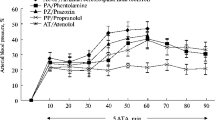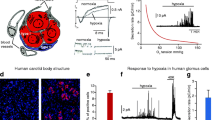Summary
The fine structure of the carotid body of the rat and the rabbit was studied after increase of the CO2-content (10% CO2, 20% CO2, 60% CO2 and 75% CO2 with sufficient O2) of the air. After breathing air containing 10 or 20% CO2 for 5 to 20 min no striking changes in the fine structure were observed. After the test animals had breathed an air mixture containing 60% resp. 75% CO2 and 25% resp. 23.5% O2 for from 1 to 4 min the following alterations in the carotid body occurred:
-
1.
The cytoplasm of the receptor cells shows a high degree of edema.
-
2.
In the receptor cells showing strong edema most of the catecholamine bodies are disintegrated. The membrane of the catecholamine bodies ruptures and their osmiophilic cores pass into the cytoplasm of the receptor cell.
Under these conditions no alterations were found in the nucleus, in the perinuclear cleft or in the mitochondria. In contrast to our earlier experiments with O2-deficiency the experiments with excess CO2 showed no increase in the discharge of catecholamine bodies into the intercellular spaces.
Zusammenfassung
Die Feinstruktur des Glomus caroticum der Ratte und des Kaninchens wurde nach Erhöhung des CO2-Gehaltes auf 10%, 20%, 60% und 75% bei ca. 25% O2 in der Atemluft untersucht. Nach 5 bis 20 min langer Atmung einer 10% oder 20% CO2-haltigen Luft konnten noch keine sicheren feinstrukturellen Veränderungen festgestellt werden. Wenn die Versuchstiere 1 bis 4 min lang ein Luftgemisch aus 60–75% CO2 und Sauerstoff geatmet hatten, traten folgende Veränderungen im Glomus caroticum auf:
-
1.
Das Cytoplasma der Receptorzellen ist ödematös geschwollen.
-
2.
In den besonders stark Ödematösen Receptorzellen zerfällt der größte Teil der Catecholaminkörper. Dabei rupturiert ihre Membran, und ihr osmiophiler Inhalt geht in das Cytoplasma der Receptorzellen über. Demgegenüber bleiben der Zellkern, der perinucleäre Spalt und die Mitochondrien normal. Im Gegensatz zu unseren früheren O2-Mangelversuchen konnte nach vermehrter CO2-Atmung keine Entspeicherung der Catecholaminkörper in die Interzellularräume beobachtet werden.
Similar content being viewed by others
Literatur
Blümcke, S., J. Rode, and H. R. Niedorf: The carotid body after oxygen deficiency. Z. Zellforsch. 80, 52–77 (1967).
Katsaros, B.: Die Rolle der Chemoreceptoren des Carotisgebietes der narkotisierten Katze für die Antwort der Atmung auf isolierte Änderung der Wasserstoffionenkonzentration und des CO2-Druckes des Blutes. Pflügers Arch. Ges. Physiol. 282, 157–178 (1965).
—: Der Effekt der Durchtrennung der Sinusnerven auf die Atmung der narkotisierten Katze bei konstant gehaltenem arteriellen Druck und seine Abhängigkeit vom CO2-Druck. Pflügers Arch. Ges. Physiol. 282, 179–185 (1965).
—, A. W. T. Edwards, J. F. Perkins jr. u. H. H. Loeschke: Antwort der Ventilation auf Perfusion der vom übrigen Kreislauf isolierten Chemoreceptoren des Carotisgebietes mit Lösungen, in denen CO2-Druck und Wasserstoffionenkonzentration variiert wurden. Pflügers Arch. Ges. Physiol. 282, 200–208 (1965).
Schoedel, W.: Die Atmungsregulation. In: Handbuch der allgemeinen Pathologie, Bd. V/1, S. 295–324. Berlin-Göttingen-Heidelberg: Springer 1961.
Schulz, H.: Über den Gestaltwandel der Mitochondrien im Alveolarepithel unter CO2- und O2-Atmung. Naturwissenschaften 43, 205 (1956).
—: Die Pathologie der Mitochondrien im Alveolarepithel der Lunge. Beitr. path. Anat. 119. 45–70 (1958).
—: Die submikroskopische Anatomie und Pathologie der Lunge, S. 60 ff. Berlin-Göttingen-Heidelberg: Springer 1959.
Author information
Authors and Affiliations
Additional information
Mit Unterstützung durch die Deutsche Forschungsgemeinschaft.
Rights and permissions
About this article
Cite this article
Blümcke, S., Niedorf, H.R. & Rode, J. Das Glomus caroticum nach CO2-Erhöhung in der Atemluft. Z.Zellforsch 81, 557–570 (1967). https://doi.org/10.1007/BF00541014
Received:
Issue Date:
DOI: https://doi.org/10.1007/BF00541014




